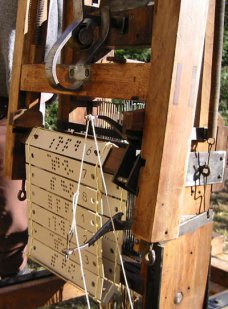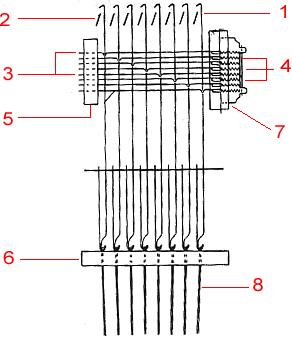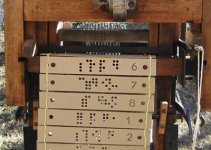- Home
- Resurrection ▾
-
Learn ▾
- Free library
- Glossary
- Documents
- Initiation
-
Shaped fabrics
- Introduction
- Popularization
- Definitions
- Le métier de façonné
- Principes du façonné
- Mécaniques de façonné
- Le jeu des crochets
- Les cartons
- Chaîne des cartons
- Mécanique 104 en détail
- Pour en finir
- Montage façonné
- Empoutage 1/3
- Empoutage 2/3
- Empoutage 3/3
- Punching, hanging and dip
- Autres façonnés
- Façonnés et Islam
-
Cours de tissage 1912
- Bâti d'un métier
- Le rouleau arrière
- Les bascules
- Formation du pas
- Position de organes
- Mécanique 104 Jacquard
- Fonctionnement 104
- Lisage des cartons
- Le battant du métier
- Le régulateur
- Réduction et régulateur
- Mise au métier d'une chaîne
- Mise en route du métier
- Navettes à soie
- Battage
- Ourdissage mécanique
- Préparation chaînes et trames
- Equipment ▾
- Chronicles ▾
- Fabrics ▾
- Techniques ▾
- Culture ▾
- Language ▾
Cardboards
If the wire is caught, the hook must be lifted so its needle should not move. In order for this needle not to be pushed back into the veneer of the carton, it suffices for a hole to face it in the carton.
If the wire is left, the hook should not be raised so its needle should be pushed back. In order for this needle to be pushed back into the veneer of the cardboard, it is sufficient that there is no hole facing it in the carton. Thus, the cardboard will repel it.
It is therefore sufficient to make holes in the cardboard in front of the needles which must not be pushed back so that their hooks rise, followed by the warp threads.
A hole on the cardboard thus corresponds to a thread taken, and no hole, to a thread left.
On each frame, a pickup will involve a hole in the carton.
It is when the cardboard of one weft is pressed against the end of all the needles 3 which protrude from the needle plank 5 that some needles are pushed back and others are not.
We have previously understood that we can codify the play of a warp thread with each stroke of frame by saying:
The warp thread is caught or the warp thread is left.
It is taken if it passes over the frame. It must be lifted by its hook.
It is left if it passes below the frame. It should not be lifted by its hook.
The information is then easy to transmit thus to the mechanics of fashion. It is the role of cartons to transmit this information to him. We must, for each frame to pass, indicate to the mechanics which are the hooks to be lifted. For this purpose we will use one carton for each frame, and write on this card, in one way or another, which hooks must rise for this frame.
Cardboards



